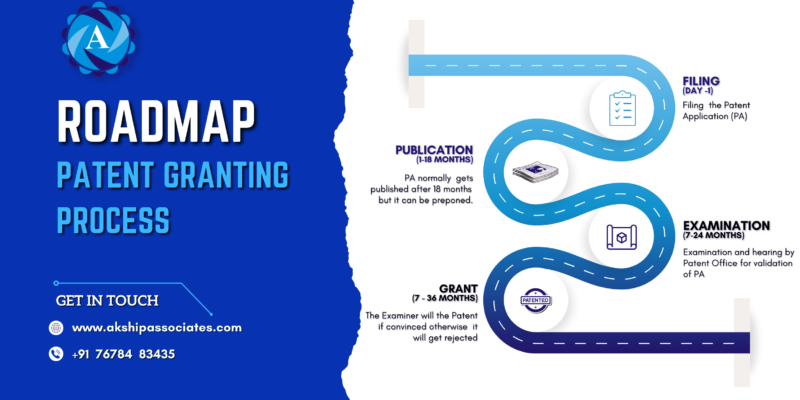
- June 23, 2023
- By Akshi@123
- Comments 0
Welcome to our comprehensive guide on the road map to the patent granting process. If you have a groundbreaking invention and wish to safeguard your intellectual property, it is vital to comprehend the intricacies of the steps involved in obtaining a granted patent. From the initial filing of the patent application to the subsequent examination and validation conducted by the patent office, each stage holds significant importance in securing exclusive rights to your invention. In this blog, we will navigate through the pivotal milestones of the patent granting process, shedding light on crucial aspects such as the publication of the application, the thorough examination procedures, and the ultimate determination of whether the patent is granted or rejected. Whether you are a novice inventor or seeking to enhance your understanding of the process, join us as we delve into the nuances of patent protection. Let us embark on this journey together and unravel the intricate path to obtaining a granted patent for your groundbreaking creation.
Filing the Patent Application
The first step in the patent granting process involves filing a comprehensive patent application. This includes preparing a detailed description of the invention, outlining its technical aspects, features, and potential applications. Additionally, the application must include well-drafted claims that define the scope of protection sought for the invention. Accompanying drawings or diagrams may also be necessary to illustrate the invention’s structure or operation. It is advisable to seek professional assistance from patent attorneys or agents, such as AKSH IP Associates, to ensure accurate and thorough documentation of the invention.
Publication of Patent Application
After filing the patent application, it enters the publication stage. This stage typically occurs within a timeframe of 1 to 18 months from the filing date or priority date. During this period, the patent office reviews the application to ensure compliance with formal requirements and then publishes the application in a publicly accessible database. AKSH IP Associates can provide guidance on the publication process and help monitor any developments related to the published application.
Examination and Validation by the Patent Office
Once the patent application is published, it proceeds to the examination phase. Here, a patent examiner from the respective patent office evaluates the application’s technical and legal aspects. The examiner assesses whether the invention meets the criteria for patentability, which typically include novelty, non-obviousness, and industrial applicability. The examiner may issue office actions or requests for clarifications, amendments, or additional information to ensure a thorough evaluation of the invention’s patentability. During this stage, AKSH IP Associates can assist in formulating effective responses to address any concerns raised by the examiner.
Grant or Rejection of Patent Application
Based on the examination and evaluation process, the patent office determines whether to grant or reject the patent application. If the examiner is convinced that the invention meets the patentability criteria, a patent will be granted. This grant provides the inventor with exclusive rights to the invention for a specific period. However, if the examiner identifies deficiencies or concludes that the invention lacks novelty or inventiveness, the application may face rejection. In such cases, AKSH IP Associates can help in strategizing appropriate responses, including amending the claims, providing arguments, or presenting additional evidence to overcome the objections raised by the examiner.
Navigating the patent granting process requires meticulous attention to detail and a thorough understanding of intellectual property laws. Consulting with experienced patent attorneys or agents, like AKSH IP Associates, can greatly enhance the chances of obtaining a granted patent. Their expertise and guidance can help in maximizing the scope of protection for the invention and ensuring a smooth and successful patent prosecution journey.




Comments (0)